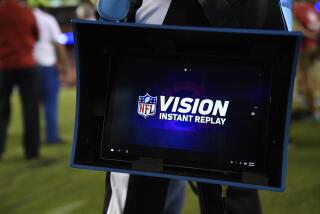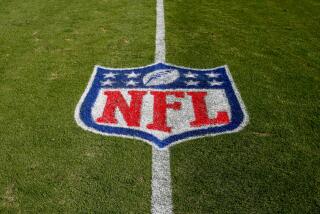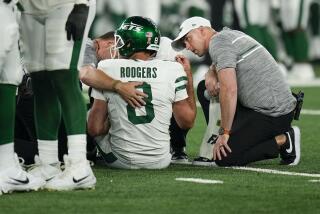In treating concussions, NFL needs to do more
Posters in the locker room, stricter guidelines on the field, investments in research â all of those are good things.
But if the NFL wants to be taken seriously on the issue of treating concussions, itâs got to do more.
Namely, no more Philadelphia-type fiascos.
A look back to Sunday: In the second quarter of a season opener between the Green Bay Packers and Philadelphia, two Eagles players suffered concussions in rapid-fire succession.
First, quarterback Kevin Kolb was sacked from behind and his head was driven to the turf. Next, middle linebacker Stewart Bradleyâs head collided with a teammateâs hip, knocking Bradley so loopy he staggered like a punch-drunk boxer and fell again before trainers escorted him off the field.
Concussions happen in football, thereâs no getting around that. The problem was, both Kolb and Bradley were cleared to return to the game, exposing them to the possibility of devastating consequences had they suffered another one.
Bradley, whose sideways-leaning shuffle was shown in TV replays and on the stadium video board, was sidelined for only four minutes â real time, not game time â whereas the standard concussion test takes five minutes. He was in for a few plays when he came back, although he sat out the final defensive series of the half, then the rest of the game. He has yet to return to practice.
Kolb reentered the game before halftime too, although trainers had substantially more time to check him. The Eagles say he seemed OK, but by halftime he was showing signs of a concussion, including blurred vision and an inability to remember certain plays. Like Bradley, he was benched for the second half and has not practiced this week.
There were a lot of other injuries in that game, apparently creating confusion on the sideline, where some of the training staff was dealing with Kolb and the others with Bradley.
After the game, Coach Andy Reid defended the decision to put both players back in, saying they had satisfactorily answered a doctorâs questions.
But thatâs not the NFLâs new standard for dealing with concussions. Players are supposed to be completely free of symptoms before being cleared to return to a game or practice â and it cannot happen on the same day the player was concussed. Clearly, neither Kolb nor Bradley was symptom-free.
Just as disturbing, the next day the NFL and the NFL Players Assn. said they were satisfied with the way the Eagles handled the situation and that the team adhered to the new guidelines. The endorsements felt rushed and almost dismissive. The NFLPA later backed off a bit after taking another look at the Bradley video.
What the Eagles did (or didnât do) wasnât sinister, but it was sloppy. They donât want to expose their players to further injury, and almost certainly wouldnât have if they could have made those decisions again. They were very cautious, for instance, in dealing with Brian Westbrookâs concussions last season. This time, safety slipped through the cracks.
Some suggest the NFL should take a page from boxingâs book and assign a neutral physician â like a fight doctor â to monitor games and make the decisions for both teams about which players should be allowed to return. That would take pressure off team doctors.
Interesting as that solution might be, it assumes a team doctor is incapable of making a reliable diagnosis. Thatâs a big assumption. Also, with injuries as difficult to detect as concussions, itâs an advantage to have a doctor who is around the players all the time and can recognize when one is acting out of the ordinary.
Under the new rules, a concussed player must be cleared by an independent neurologist to come back. That player can also seek a second opinion â at the teamâs expense â from a doctor of his choosing.
But teams need to do even more, perhaps bulking up their medical staffs to better cope with a situation such as the one that happened in Philadelphia. There are league employees in the press box who monitor officials, and others who look for uniform violations. Maybe someone should monitor how injuries are handled.
Whatâs more, instead of immediately giving their blessing to the team in question, the league and its players union should take a breath, investigate the situation, learn what can be learned, and then issue an endorsement or critique.
Someone needs to stand up for the players. Especially when those players can barely stand.
twitter.com/LATimesfarmer
More to Read
Go beyond the scoreboard
Get the latest on L.A.'s teams in the daily Sports Report newsletter.
You may occasionally receive promotional content from the Los Angeles Times.











